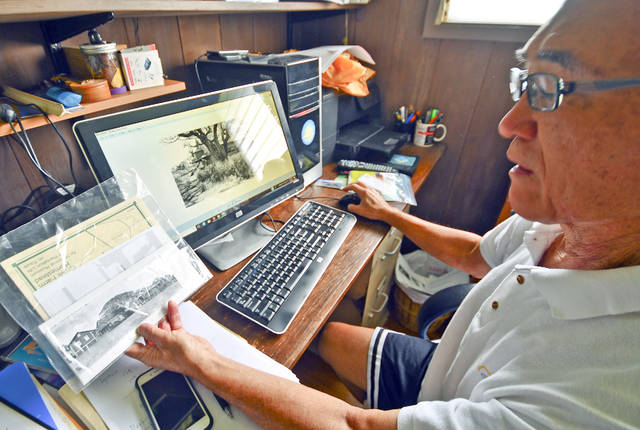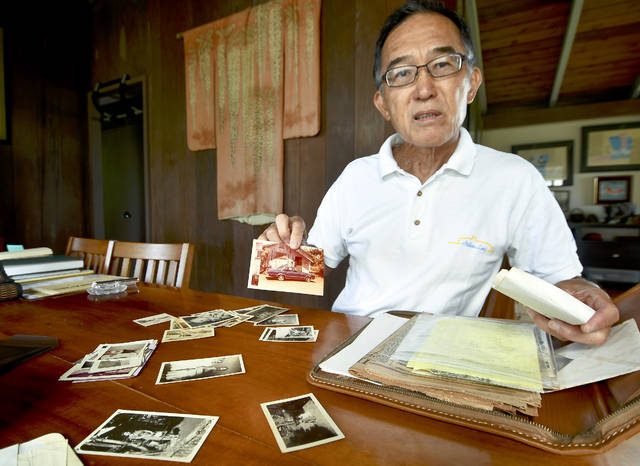Talking story with Gerald Hirata

Dennis Fujimoto / The Garden Island
Gerald Hirata looks over photos of the Buddhist church that was in the McBryde Sugar Co. Camp 2. The bell tower from the church was relocated and rebuilt at the Hanapepe Soto Zen Temple in 1979.

Dennis Fujimoto / The Garden Island
Gerald Hirata looks over old photographs of McBryde Sugar Co.’s Camps 2 and 3 in the Wahiawa gulch, including one showing a typical plantation house set up.
Gerald Hirata once described himself to former The Garden Island writer Gladys Tashiro as “da numbah three son of da only son of one son-of-a-gun,” and “the now generation” of the Hanapepe Soto Zen Temple.
Gerald Hirata once described himself to former The Garden Island writer Gladys Tashiro as “da numbah three son of da only son of one son-of-a-gun,” and “the now generation” of the Hanapepe Soto Zen Temple.
These days, he is thinking of the Wahiawa ‘85 Reunion and the 700-plus people who celebrated, over three days, the unmarked town before it was razed by the McBryde Sugar Company.
“The residents of the camp organized a reunion so former residents could come home one last time and say ‘goodbye’ to their hometown,” Hirata said.
“This event was sanctioned by the state’s 100th anniversary of the Japanese immigration to Hawaii 1885-1985 Celebration, a year-long celebration commemoration of the kanyaku-imin. The reunion was held after McBryde Sugar Company announced its decision to remove all of the remaining homes, buildings and temple of Camp 2, Wahiawa Gulch, and 3, adjacent to Camp 2. Two of the buildings were not razed — the community hall and Kimata Store. Today, the only remaining buildings of the two camps are the old Kimata Store in Camp 2, some concrete foundations of the community hall, the old Buddhist temple bell tower which is at the Hanapepe Soto Zen, and the cement entry gates to the temple grounds.”
He remembers speaking with Charles Hillinger of the Los Angeles Times who came to report on the ‘85 Reunion.
“It’s sad,” Hirata said. “I dread the finality. To visit your hometown and know you will never see it again doesn’t happen to too many people.”
Hillinger describes Wahiawa thusly: “No signs point to Wahiawa, five miles east of Hanapepe along Halewili Road, although that is where the turnoff to the village is. The obscure village, hidden from the outside world for 87 years by fields of tall sugar cane, is reached by a narrow, winding red dirt road, not unlike scores of other similar no-name roads that disappear into sugar cane fields.”
McBryde Sugar Company had a network of 18 camps ranging from the Hanapepe River to Kukuiula to house its work force consisting of Japanese, Filipino, Portuguese, Puerto Rican and a few Chinese and Koreans.
Camps 1 through 7 were collectively known as Wahiawa. Camp 8 was located where Brydeswood is, today; Camp 9 was Niumila (New Mill), Camp 10 was called Lawai Stable (located in the lower reaches of Kalaheo). Camps 11-17 were tiny settlements alongside McBryde’s network reservoirs makai of Koloa Road in the Lawai area to Kukuiula.
Most of Camp 1 was destroyed in the 1947 tidal wave. Camps 2, 6 and 7 housed primarily Filipino workers. Camp 3 was primarily Japanese. Camps 4 and 5 were destroyed when disaster struck the nearly completed Alexander Dam in 1930, causing extensive flooding in the Wahiawa Gulch.
Camp 9 was a mixture of various ethnic groups including Filipino, Japanese, Puerto Ricans and Portuguese, as was the make-up of the remaining camps.
Plantations started recruiting laborers from Japan 133 years ago to work in the fields.
“It was Feb. 8, 1885, that the first party of immigrant laborers from Japan — 676 men, 159 women and 108 children — arrived in Hawaii on the steamship City of Tokyo,” Hillinger wrote. “They came to work 10 hours a day, six days a week in the cane fields, men receiving $9 a month, women $6 a month. During that time, laborers in Japan were paid 10 cents a day, less than $3 a month. The immigrants came planning to work a few years in Hawaii, save enough money to return to Japan and live a more comfortable life — few returned.”
The Los Angeles Times reporter wrote: “The name of the village — a camp for men, women and children who in the past toiled long hours for little pay — never has appeared on maps of the island. Today (1985), the village is in ruins, choked with weeds. Homes are in various stages of collapse, some completely caved in with roofs resting on the ground. The community’s 1918 Buddhist temple is abandoned, its walls and ceiling ripped apart by a hurricane (Hurricane Iwa).”
The sites of Camps 2 and 3 are currently leased to DuPont Pioneer by Alexander &Baldwin.
Where you born and raised in Wahiawa?
My grandfather, Sadao, and grandmother, Teru Hirata, were among the first people living in Wahiawa in 1889. My grandfather lived for 92 years.
My father, Sadao “Dickie” (he and my mom both had American names) Hrata was born in 1914 and resides in Wahiawa Camp 2.
My mother was Fumiko “Flora” Hirata, and I, too was raised in Wahiawa, except that I was born at Wilcox Hospital.
We lived in Camp 2, House No. 14 until 1969, the year I graduated college. My parents then moved to Niumila, Camp 9, House No. 117 and lived there until 1985 when they moved to Eleele Nani where McBryde Sugar Company had set aside land for its employees to purchase at discounted prices.
I was born in 1947, so the decade and a half between 1950 to 1965 were my kindergarten through high school years. We were the front end of the growing Baby Boomer generation, absorbing the prosperity of the ‘50s and its pop culture.
On Kauai, from one end of the island to the other, almost all of the arable land was cultivated by sugar cane or pineapple.
There were 10 sugar plantations and three pineapple canneries.
During this time, Camp 3 had about 100 families, primarily Japanese with a few Portuguese, Puerto Rican,and one Hawaiian family.
Camp 2 had about six Japanese families, about a dozen Filipino families, and many single Filipino men.
What makes Wahiawa so special to me is the people — the camp folks. My childhood images are of playmates who were in endless supply, and the old folks who were home tending to the yard or garden, and keeping an eye over us while our parents were at work.
We knew every household, who were the older and younger siblings of classmates, their parents, grandparents, cousins, aunts and uncles. Wahiawa was one, big extended family.
It was a country life of hearts and feelings. I remember it as a camp full of life with Friday night movies at the community hall, numerous church functions like bazaars and bon dances, camp picnics and Little League baseball.
Education, the advancement of technology and the modern way of life contributed to people moving on to other places, the first steps of the community’s dissolution.
When the last homes of Wahiawa are razed by the plantation, the camp will no longer exist. As residents of the camp, we saw this day coming and have accepted it without any trace of bitterness or remorse. What changes for me is the landscape — the rows of houses and the temple will be gone, but my attitude remains unchanged.
I still think of myself as a Wahiawa boy, a person whose identity was shaped by that dusty, little McBryde enclave.
Who are some of the other people who are connected to the Wahiawa camp?
During the Reunion ‘85, two United States senators, the governor of the state of Hawaii, and the mayor of Kauai were all of Japanese ancestry. Two of the camp’s most famous progeny were Senators Daniel Inouye and Spark Matsunaga.
Asakichi and Moyo Inouye, senator’s grandparents, came to work for McBryde and arrived with 4-year-old Hyotaro, senator’s father, living in Camp 3 until Hyotaro was 8 years old. The family moved to Honolulu where Sen. Dan was born in 1924.
Kingoro and Chiyono Matsunaga worked at McBryde Sugar and lived in Camp 18 in Kukuiula where Sparky was born in 1916. The family moved to Hanapepe when Sparky was 4 years old.
Gov. George Ariyoshi was in office, the first American of Japanese ancestry to serve as governor of an American state. His father was a sumo wrestler in Japan and came to Hawaii to work as a laborer, later running a dry cleaning shop.
The bell tower at the Hanapepe Soto Zen is originally from the Wahiawa camp. When was the relocation completed?
Yes. That project was completed in 1979, a year following the building of the temple. At that time, I was living in Los Angeles, and a group of former residents spearheaded an effort to help raise funds to get the bell tower moved. More than $1,000 was raised from the LA area.
Most of the rocks that formed the base of the bell tower was moved stone by stone, marked and transported to Hanapepe with the help of other McBryde Sugar employees and using McBryde equipment and trucks.
The base of the bell tower were the original stones from the Wahiawa temple. The pillars at Hanapepe were built of concrete, and a new roof was built, duplicating and matching the previous original style.
The temple, built in 1978, was constructed by temple members, nearly all of whom were employed by McBryde Sugar Company.
As plantation workers, these members themselves possessed skills as carpenters, painters, plumbers, electricians, drafting, tool and die makers, and other craftsmanship. As a result, they were able to construct the temple from the ground up and retain the temple’s character with its roofline, shoji doors, pillars and preserving the intricate design and motifs of the original temple.
Any other thoughts on Wahiawa?
Today, the present bell tower roof is in need of repair as is the original 1979 structure. I remember the Eleele Festival put on by the McBryde workers to help raise funds for the original temple. These festivals were put on by the workers who came from many different cultures, and I would like to see these happen again — the coming together of many hands and many roots to help someone else.
In reality, life was not all roses as plantation life was difficult with struggles and labor strife, hard work, low wages, and offering little in terms of compensation.
For our grandparents, it was the start of a new life in a new country. For our parents, the dream continued and they worked hard to give us a better life — and they did.
That is the reason we can look back with fondness and nostalgia — because it was their struggles and hard work that gave us the opportunities to move forward.
•••
Dennis Fujimoto, staff writer and photographer, can be reached at 245-0453 or dfujimoto@thegardenisland.com.

